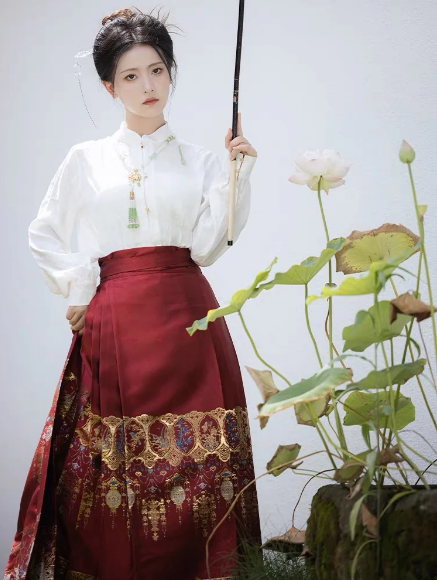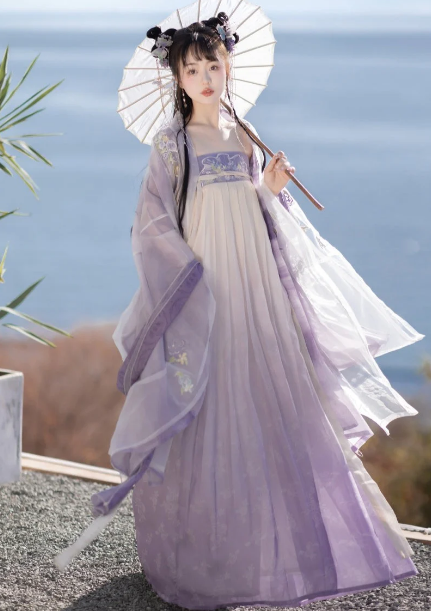Modernized Hanfu blends cultural heritage with contemporary fashion, offering beauty and identity expression but may lack practicality.
The Advantages of Modernized Hanfu
Cultural Preservation and Expression
Modernized Hanfu embodies a deep reverence for Chinese cultural heritage. Individuals who choose to wear Hanfu actively participate in preserving a rich historical legacy. This clothing style becomes a dynamic symbol of national pride and cultural identity. Embracing ancient traditions, modernized Hanfu makes history tangible and accessible in today’s world. For example, different styles signify various dynasties, offering an educational journey through China’s past. Wearing Hanfu today effectively bridges the gap between historical reverence and contemporary living, making it more than just a fashion choice but a living narrative of Chinese culture.

Comfort and Adaptability to Modern Lifestyles
Modern Hanfu designers masterfully combine traditional elegance with contemporary practicality. They use breathable, lightweight materials, making Hanfu suitable for diverse climates and occasions. This adaptability has expanded Hanfu’s appeal across a wide demographic spectrum. Modern modifications, like adding pockets, cater to the practical needs of today’s wearers. These thoughtful integrations ensure that modern Hanfu not only respects traditional aesthetics but also fits comfortably into the rhythm of modern life. This blend of old and new makes Hanfu a versatile choice for various settings, from formal gatherings to everyday wear.
Diversity in Design and Personalization
The modern Hanfu movement celebrates an impressive diversity in design and personalization options. Today, individuals can choose from a vast array of styles, colors, and patterns, each reflecting a unique aspect of traditional Chinese aesthetics. This variety empowers wearers to express their personal style while still paying homage to their heritage. The rise of numerous Hanfu designers and brands has further fueled this diversity. For instance, some infuse traditional patterns with modern graphic elements, striking a balance that resonates globally. Personalization extends to the way people accessorize and style their Hanfu, blending traditional attire with contemporary fashion elements. This approach not only preserves the essence of Hanfu but also makes it a living, evolving form of cultural expression.
Through these aspects, modernized Hanfu stands out as a unique symbol of cultural preservation, practicality in modern living, and creative expression. It represents a harmonious blend of respecting the past while embracing the present, making it a relevant and cherished part of contemporary life.
The Challenges of Modernized Hanfu
Practicality and Convenience in Everyday Use
Despite its beauty, modernized Hanfu often faces practical challenges in daily use. Its intricate designs and layers can be cumbersome, especially in fast-paced urban environments or for those with active lifestyles. For example, the long sleeves and flowing skirts, while elegant, are not always conducive to activities like commuting on public transport or in crowded spaces. The traditional tying methods of Hanfu garments, such as sashes and knots, might require more time to put on compared to contemporary clothing, posing a challenge for those with a busy schedule. This aspect of Hanfu can be a significant barrier to its integration into daily wardrobes, particularly for individuals who prioritize convenience and ease of wear.
Social Perception and Acceptability
Hanfu, while gaining popularity, still faces hurdles in social perception and acceptability. In some contexts, wearing Hanfu can attract undue attention or curiosity, which might be uncomfortable for the wearer. There’s a fine line between appreciation and cultural stereotyping, and sometimes wearers of Hanfu find themselves having to explain or justify their choice of attire. This challenge is particularly evident in international settings, where the cultural significance of Hanfu might not be well understood. There are debates within China about when and where it’s appropriate to wear Hanfu, with some people viewing it as suitable only for special occasions or cultural events, rather than everyday wear.
Care and Maintenance Requirements
The care and maintenance of modernized Hanfu can be demanding. These garments often require delicate handling and specific washing techniques to preserve their quality and appearance. For instance, many Hanfu fabrics are not suitable for machine washing or harsh detergents, necessitating hand washing or professional cleaning services. This requirement can be a deterrent for potential wearers, especially those who lack the time or resources for such upkeep. The storage of Hanfu can also be a challenge, as these garments often need ample space and proper conditions to avoid damage, unlike more conventional clothing that can be easily folded and stored in compact spaces.
Each of these challenges highlights the complexities of incorporating traditional attire into modern life. While modernized Hanfu is a beautiful and meaningful way to connect with cultural heritage, it requires a balance between practicality, social acceptability, and maintenance efforts. These factors play a crucial role in determining the extent to which Hanfu can be a regular part of contemporary wardrobes.
Balancing Tradition and Modernity
Integrating Traditional Elements in Modern Contexts
The integration of traditional Hanfu elements into modern contexts is a creative endeavor that requires both respect for heritage and an understanding of contemporary trends. Designers skillfully infuse traditional motifs and fabrics into clothing that suits today’s lifestyles. For instance, the use of silk – a material deeply rooted in Chinese history – finds new expression in modern Hanfu designs that are both elegant and wearable in daily life. Another approach is the adaptation of traditional Hanfu patterns into accessories like scarves or bags, making them more accessible and functional for modern consumers. This integration is not just about aesthetics; it’s a thoughtful blend of history and functionality. It allows people to appreciate the beauty and intricacy of traditional designs while enjoying the comforts of modern materials and techniques.
Modernized Hanfu as a Bridge Between Past and Present
Modernized Hanfu acts as a unique bridge between the past and the present, offering a tangible connection to history while catering to contemporary sensibilities. This fusion creates a dynamic dialogue between different eras, allowing wearers to experience and express a sense of continuity with their cultural heritage. By wearing modernized Hanfu, individuals not only honor the traditions of their ancestors but also carry these traditions forward in a relevant and meaningful way. For instance, wearing Hanfu during traditional festivals or significant cultural events becomes a powerful statement of cultural continuity and identity. This connection is not merely symbolic; it’s a living practice that rejuvenates ancient customs and values, making them pertinent to the modern world. The modernized Hanfu movement thus becomes a catalyst for cultural preservation, promoting an understanding and appreciation of Chinese history and traditions among younger generations.
Through these efforts, the balance between tradition and modernity in the context of Hanfu is not just a fashion statement but a cultural movement. It’s a conscious effort to respect and revive a rich heritage while adapting to the needs and expectations of contemporary life. This balance is crucial in ensuring that traditional practices are not lost but are instead reinterpreted and reintroduced to fit the modern world.

Impact on Personal Identity
Expressing Individuality Through Modernized Hanfu
Modernized Hanfu offers a unique platform for individuals to express their personal style and identity. This attire enables wearers to stand out in a crowd, showcasing their affinity for cultural elegance. The diversity in designs, colors, and customization options allows for a high degree of personal expression. For example, some may choose bold colors and intricate patterns to make a statement, while others might prefer subtle hues and simpler designs for a more understated look. This choice goes beyond mere fashion; it’s a reflection of one’s personality and values. The ability to mix traditional Hanfu elements with modern accessories further enhances this personal expression, allowing wearers to create a look that is truly their own. Modernized Hanfu thus becomes a canvas for self-expression, where each outfit tells a personal story, reflecting the wearer’s unique journey and connection to their heritage.
The Role of Modernized Hanfu in Cultural Identity
Modernized Hanfu plays a significant role in shaping and reinforcing cultural identity. For many, it is a symbol of cultural pride and a connection to Chinese heritage. Wearing Hanfu can evoke a sense of belonging and affinity with Chinese history and traditions. It’s particularly impactful among the younger generation, who are navigating their identity in a globalized world. By embracing Hanfu, they can explore and reaffirm their cultural roots. This connection is not just about wearing traditional clothing; it’s about participating in a larger cultural narrative. It includes engaging with the customs, stories, and values that Hanfu represents. For the Chinese diaspora, modernized Hanfu offers a tangible link to their homeland, helping them stay connected with their cultural background. It becomes a medium through which they can celebrate and share their heritage with the wider world.
In both these aspects, modernized Hanfu transcends its role as mere attire and becomes a powerful tool for personal and cultural expression. It allows individuals to showcase their uniqueness while staying connected to a rich cultural tapestry. Through modernized Hanfu, wearers can navigate the complexities of identity in the modern world, blending tradition with personal style in a way that is both meaningful and relevant.







